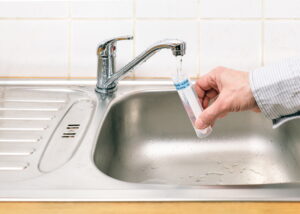At Bayonet Plumbing, Heating & Air Conditioning, we recognize the importance of having clean, safe water for your family. Unfortunately, many Florida homeowners encounter water quality issues, such as mineral buildup, unpleasant tastes, and strong odors. If you’ve noticed any of these concerns, it’s essential to take action. This guide will explore the common causes of poor water quality and effective solutions—such as water purification in Lakeland—to help ensure your household has fresh, contaminant-free water.
Bayonet Plumbing, Heating & Air Conditioning Blog: Posts Tagged ‘water purification’
We Have Solutions for Your Home’s Hard Water Problem
Monday, February 10th, 2025At Bayonet Plumbing, Heating & Air Conditioning, we understand the importance of having clean, safe water in your home. If you reside in Florida, you might already be aware of the common water quality challenges in the area. Issues such as hard water and chemical contaminants can impact not only your health but also the durability of your plumbing system and appliances. Fortunately, we provide a variety of water treatment solutions, including water purification in North Port, to enhance the safety, purity, and taste of your water. Read on to learn more about the water quality problems that Florida homeowners frequently encounter and how we can help resolve them.
How Whole House Water Purifiers Are Better Than Portable
Monday, February 10th, 2025When considering water filtration, homeowners often try to make do with portable units available from big-box stores rather than investing in a whole-house option. While both improve water quality, whole house systems offer superior filtration, efficiency, and convenience that more than make up for the initial cost and inconvenience of installation. Bayonet Plumbing, Heating & Air Conditioning recognizes the importance of clean water for your health, home, and overall well-being. That’s why we’re the perfect company to hire when you really want to tackle poor water quality in your home. Here’s why investing in a whole house water purifier is the best long-term solution for water purification in Sarasota.
How to Address Hard Water Issues in Florida
Monday, February 10th, 2025Hard water is a widespread concern for homeowners in Florida due to elevated levels of minerals such as calcium and magnesium in the water supply. This can lead to various problems, including limescale buildup, clogged pipes, and reduced efficiency in household appliances. If left untreated, hard water can shorten the lifespan of plumbing systems and appliances while making daily household tasks more difficult. Understanding the signs of hard water and exploring effective solutions can help maintain better water quality in your home. Whether you’re considering water purification in Ocala or installing a reverse osmosis system, our team is here to guide you through your options.
Solutions for Your Florida Home’s Poor Water Quality
Monday, February 3rd, 2025At Bayonet Plumbing, Heating & Air Conditioning, we understand how essential clean, high-quality water is for your home and family. Unfortunately, many homeowners in Florida experience issues with water quality, from hard water buildup to unpleasant tastes and odors. If you’ve noticed any of these problems, it’s time to take action. In this guide, we’ll explore the common causes of poor water quality and effective solutions such as water purification in Tampa to ensure your home has clean, safe water.
Problems With Your Home’s Water Quality? We Have Solutions
Monday, February 3rd, 2025At Bayonet Plumbing, Heating & Air Conditioning, we know how vital clean, safe water is for your home. If you live in Florida, you may already be familiar with some of the common water quality issues in the area. From hard water to chemical contaminants, poor water quality can affect everything from your health to the longevity of your plumbing. Fortunately, we offer a range of solutions including water purification in Clermont to ensure your water is safe, clean, and great-tasting. Keep reading to learn about the common water issues Florida homeowners face and how we can help.
Why Whole House Water Purifiers Are Better Than Portable Units
Monday, February 3rd, 2025At Bayonet Plumbing, Heating & Air Conditioning, we understand that clean water is essential for your health, home, and overall well-being. When it comes to water filtration, homeowners often debate whether to invest in a professionally installed water purifier or rely on portable units. While both options improve water quality, whole house systems provide superior filtration, efficiency, and convenience. Let’s break down why a whole house water purifier is the best long-term solution for water purification in Jacksonville.
How to Combat Hard Water in Your Florida Home
Monday, February 3rd, 2025Hard water is a common problem for homeowners in Florida. With high levels of minerals like calcium and magnesium in the water supply, many households experience issues ranging from limescale buildup to clogged pipes and inefficient appliances. If left untreated, hard water can reduce the lifespan of plumbing systems and make everyday tasks more challenging. Here’s what you need to know about identifying and combating hard water problems effectively. From water purification in Fort Myers to reverse osmosis systems, contact our team to learn about your options.
Water Quality! Part Two
Monday, April 2nd, 2012There are several things in life that we take for granted. Water is very often one of them. Each of us uses this vital liquid, the most common substance on earth, everyday. And we rarely think twice about it.
However, the water we use for cooking, drinking, and countless other domestic tasks will quickly catch our attention when there is some sort of problem.
Fortunately, some of the most obvious water problems are also the easiest to solve. The problems in this blog are considered aesthetic and are not considered harmful to health, they do affect the look and taste of the water, and may cause it to be undrinkable by some people’s standards. Addressing these water quality problems is important. Issues such as taste and odor, color, and turbidity (cloudiness) are all aesthetic water problems, and all have relatively simple solutions.
In order to treat these problems, we must first look at their source. Water is known as the universal solvent. Before it reaches a consumer’s tap, it comes into contact with many different substances, such as gases, minerals, and organic matter. Water picks up traces of these substances, and unfortunately, some of them may cause taste, odor, color, or turbidity problems for the consumer.
Turbidity: Cloudy Water
At one time or another, most consumers have encountered water that appears cloudy or foggy. This characteristic is due to turbidity: the presence of finely divided solid particles in water. These particles may be inorganic mineral matter which does not dissolve, or organic matter that has been picked up as the water flows over and through the ground. The particles cause the scattering and absorption of light rays, which gives the water a cloudy appearance.
Whether turbidity is due to suspended organic or inorganic matter, it can cause staining of sinks and fixtures, and the discoloration of laundered fabrics. Inorganic turbidity can have an abrasive effect on plumbing systems and may cause physical wear or erosion on pipes and fittings. Turbidity is most commonly found at taps whose source is surface water from lakes, streams, or ponds. Treatment: filtration and water sanitizing is readily available.
Taste and Odor
Another set of problems that will quickly catch a consumer’s attention is objectionable tastes or odors present in water. These two senses appear to work in unison, which makes it difficult to separate taste and odor.
A common characteristic of water from public systems is the chlorine taste and odor, which is often quite noticeable. Many public water systems treat water with chlorine to disinfect it. Although this is an important step in the treatment of water because it destroys disease-producing bacteria and other harmful organisms that may be in present in water, there is no doubt that excess chlorine from the disinfection treatment step can make the water objectionable. A carbon-based filtration system can address this issue.
In other cases, water with a high mineral concentration may have an unpleasant soda or salty taste, and a metallic taste may be produced by the presence of iron or manganese in water.
Many people have also encountered water that contains hydrogen sulfide gas, which creates an objectionable odor. So-called “sulfur water” not only produces the obnoxious “rotten egg” odor, but is also corrosive to plumbing and can cause the rapid tarnishing of silver. Even very low concentrations of hydrogen sulfide are detectable because of the strong odor.
Various taste and odor conditions are caused by the presence of organic matter in water. Even when the amount of organic matter is very low, unusual tastes and odors such as musty, fishy, or earthy smells may be found.
Whatever your particulat water problem may be, Bayonet can provide a solution. Water can be “cleaned” using a chlorination or hydrogen peroxide based cleansing system, it can be filtered through many different types of media and we are happy to customize our filtration to meet your specific demands.
Don’t sweat, Call Bayonet !
Source: www.waq.org
Water Softening and Purification: What’s Right for Me?
Thursday, March 29th, 2012When it comes to water, there is actually a lot to know. There’s a wealth of knowledge behind getting the chemicals and minerals out of the water regardless of how they got in the water in the first place. If you’re on a well, you’re dealing with ever-changing groundwater shifts. If you’re using water provided by your city or municipality, you’re dealing with cleansing agents or minerals deemed safe or additives such as fluoride for dental health. Florida weather is some of the best in the country, but our water is some of the most challenging, and definitely among the hardest!
Here’s one important fact you should ALWAYS keep in mind: any water conditioning solutions MUST be installed by a licensed plumbing company. Make sure you’re contracting with a licensed, bonded, insured company when you choose an installation. Bayonet Plumbing and AC is Ask The Seal Certified, so you know we’re covered AND that the technician has been background checked!
It’s your choice if you’d like water cleansed or softened. There are many solutions out there that will resolve your water complaints. From softeners to remove the hardness to filter media to remove specific particulate, to reverse osmosis systems to provide ideal drinking water, to sanitizing systems to take out smells and bacteria, we’re happy to provide whichever solution you’re seeking.
Let’s start with the most commonly sought solution: water softening. Some also refer to it as water conditioning. This is a process that removes the Calcium Carbonate from the water entering your home. There are costs to consider when considering the system. The softener needs to regenerate weekly at minimum. Upon each regeneration, it uses 15 pounds of salt and 100 gallons of water. That’s a given that you have to be prepared for when you install a softener. Most softeners are set up to regenerate after a set amount of water is used, but if you don’t use enough water you won’t get the benefits you desire without a weekly regeneration. They will also reduce your water pressure at least a little even if sized properly. They also don’t change the smell or taste of your water. The smells are caused by things like harmless but nuisance bacteria that need to be killed or minerals that have to be filtered, and softeners address neither of those things. Tastes are caused by the presence of total dissolved solids, and softeners only remove the calcium present in the water, so the taste won’t change either. Softeners do effectively remove HARDNESS, and that means using less soap and detergent, a reduction in water spotting on showers and dishes, and the cleaner feeling that people are seeking.
If perfect drinking water is your perfect water solution, then a reverse osmosis system is the ideal choice. These are commonly called RO systems and can be installed in almost any situation! They filter out more than 90% of anything in the water for the ideal glass of water! The water is perfect for cooking, pets, children, and even tropical fish. There are 3-stage and 4-stage reverse osmosis filters depending on your initial water quality. As for maintenance, there is a pre-filter that requires a change every 6 months and a post-filter that requires a change annually. The main media filter requires changing too but it varies greatly by usage. The more you use an RO filter, the happier that media filter stays! Our plumbers will conduct a TDS (total dissolved solids) test to make sure that filters is working before they recommend replacement.
So there you have it: our recommendations for softening and purification solutions in a nutshell. Next week: check back for information on cleaning the water and removing smell! If you’re in need of an estimate, please let us know. We’re happy to customize the perfect water solution that will be just right for you and your family, so don’t sweat, call Bayonet!




